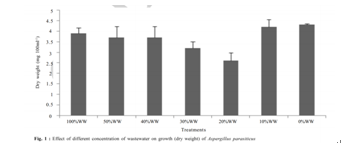Hamid Moh. Al-Gabr,
Chengsong Ye, Yongli Zhang, Sardar Khan, Huirong Lin, Tianling Zheng,Journal
of Environmental Biology, 2013, 34:353-358
Mycotoxins are considered as the most
hazardous fungal metabolites for human, animals and planthealth. Recently, more
attention has been paid on the occurrence of this group of fungi in
differentwater sources throughout the globe. In this study,Aspergillus parasiticusATCC strain was
used asrepresentative strain producing
aflatoxins in drinking water. This study aimed to investigate theactivation of
fungi in drinking water and their ability to produce aflatoxins (B1, B2, G1,
and G2) inwater under different ratios of C:N using different concentrations of
total organic carbon (TOC) andtotal nitrogen (TN). Glucose and ammonium
sulphate were used for changing the levels of TOC andTN in the selected water
media. Similarly, the effects of different water pH levels from 4.5 to 8.2
onthe growth of this group of fungi and aflatoxins production were also
investigated. The resultsindicate that the growth of fungi was highest, at C:N
ratio of 1:1 as compared to other
selectedratios. Furthermore, the findings indicate that the pH levels 5.56.5
showed best growth of fungi ascompared to other pH levels. Aflatoxin
concentrations were measured in the water samples usingHPLC technique, but
selected fungi were not able to produce aflatoxins in water at
appliedconcentrations of TOC and TN mimicking the ratios and concentrations
present in the natural aquaticenvironment.

返回

